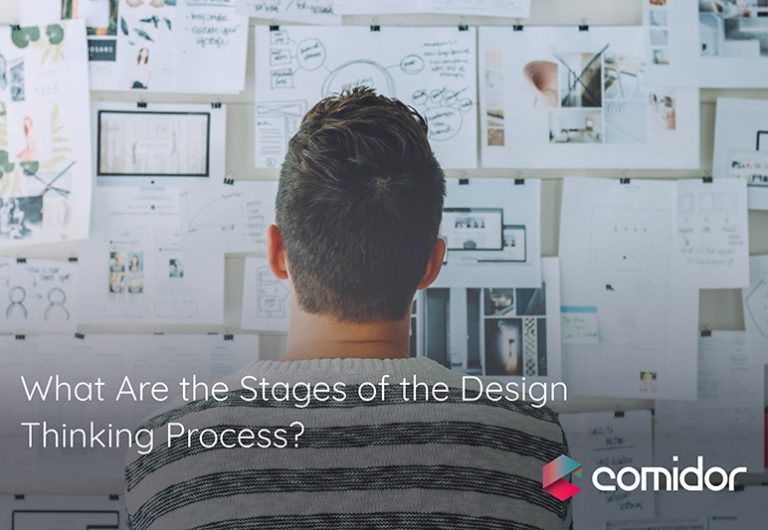Design thinking is a solution-focused approach to tackling business problems. It is one of the most important emerging trends, essentially encouraging organisations to ‘think like designers’, and a growing number of companies are investing in design thinking training, in order to benefit from more innovative strategies or approaches.
People often think of design in visual terms, seeing it purely as the creation of objects. Yet, in reality, design simply means crafting something new, in order to creatively solve an issue. This is the basis of design thinking.
Within this discipline, a five-stage model is widely deployed, helping businesses to approach this new way of thinking in a more structured way. This approach is credited to the Hasso-Plattner Institute of Design at Stanford and has gained popularity. In this blog post, we explore what the five stages of the design thinking process are. You can also read about the fundamental terms of Project Management Software like Comidor.
1. Empathy
Design thinking begins with the empathy stage, which is where an organisation attempts to gain an understanding of the business problem, why it is so important to resolve it, and who will benefit. It involves delving into the issue, removing pre-existing assumptions, and taking steps to see things from alternative points of view.
While the precise steps taken during the empathy stage will depend on the nature of the business problem or the specifics of the project, it will typically involve consulting with others to gain valuable insights. This could mean engaging with experts in the field, speaking to customers, or talking to business partners.
2. Definition
The next stage of the design thinking process is focused on defining your business problem, or framing the issue in a clear way, so that it can be easily understood and summarised. Typically, it will involve organising the insights gathered during the empathy stage and prioritising them, creating a more focused view. You can read more about
“This is where you will analyse your observations and synthesise them in order to define the core problems that you and your team have identified,” Rikke Dam and Teo Siang state, in an article created for the Interaction Design Foundation. “You should seek to define the problem as a problem statement in a human-centered manner.”
3. Ideation
At this point, the problem and the need for a solution are understood, and the issue has been framed and contextualised, so it is time to start thinking of ideas. During this ideation phase, the focus should be on the generation of as many thoughts as possible, based on what has been learned so far.
It is important not to impose too many rules during this phase, because design thinking training should always emphasise the importance of openness to ideas that are ‘outside the box’, obtuse or unusual. With that being said, easy and obvious solutions should not be overlooked during brainstorming sessions either.
4. Prototyping
With some interesting ideas and potential solutions outlined, design thinking requires organisations to start to create prototypes, which could mean creating scaled-down versions of solutions, in order to test their viability. Crucially, the creation of prototypes allows companies to see limitations or constraints, without requiring a huge outlay. Learn more about modelling a process with Comidor.
“Prototyping brings the solutions into vision”, says Prince Pal, in an article written for the Think 360 Solutions website. “Create rough drafts of solutions to decide if these will prove beneficial for the problem. A prototype can later transform into a beta product or a minimal viable product (MVP).”
As a result of the prototyping stage, businesses can understand how people will respond to the end product.
5. Testing
The final stage of the design thinking process is the testing phase. This is where a company or project team tries out the finished product in real-world settings, and subjects it to rigorous inspection, in order to evaluate its performance and make a judgment about whether or not it achieves the initial aims or objectives.
During this stage, the product may be tested internally, tested on real customers, or a combination of the two. The essential thing is that the testing phase produces clear feedback, which can be acted upon. In terms of how this benefits the business, it means problems are identified early, and can be fixed before final roll out.
The Last Word
Design thinking is usually broken down into five stages, for the sake of organisation and structure. Nevertheless, it is important to understand that while stages of the design thinking process have been defined, any of the final four steps could result in the company or team having to go back and re-visit a previous phase in the process.
For instance, testing might reveal something which forces the business to re-define the problem, while prototyping could invalidate a seemingly good idea, sending the team back to the ideation phase. Some companies also adopt a less linear approach, having two teams working on different phases, although this can be risky and inefficient.
Author Bio:
Nadine is a technical marketing director at Strategy Execution, contract management training providers with over 20 years’ experience in the global B2B sector, hands-on, creative marketer, Nadine demonstrates a passion for cutting-edge technology and a proven ability to effectively translate client priorities. Nadine is passionate about Project Management, managing and contributing to the company PM blog servicing 40,000 monthly users.





